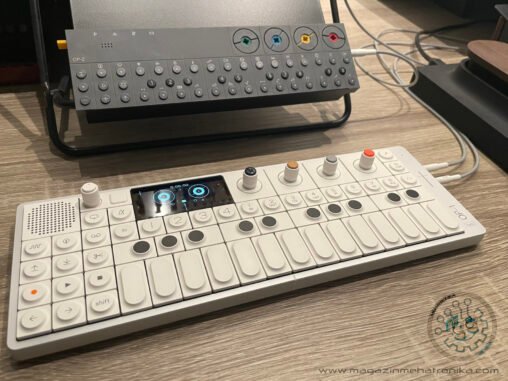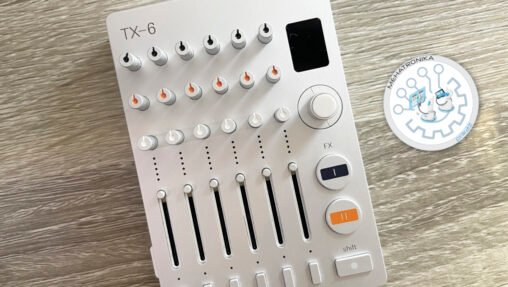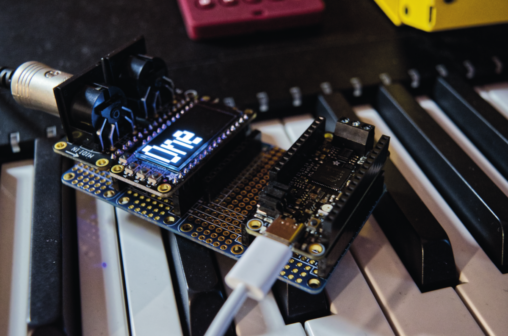teenage engineering

There is absolutely no doubt that teenage engineering’s OP-1 is one of, if not the most influential, synthesisers of the decade. However, as we’ve already seen multiple times with the Swedish brand’s products, trying to fit them into a single conventional category doesn’t do them justice. The OP-Z is more than just a sequencer, the TX-6 is more than just a mixer, so it only makes sense for the OP-1 to be more than just a synthesiser.
Aside from the legendary synth engines, the OP-1 features a powerful sampler, drum machine, effects processor, sequencer and virtual tape recorder, making the whole package feel much more like a DAW than a simple instrument.

Each time we get a bit of teenage engineering kit, it takes us on a journey during our review. The Swedish company seems to make just about anything they feel like making – which includes everything from serious, albeit quirky music devices – to adorable record cutters and singing dolls. This playful variety is what defines the brand – and what makes the brand. Reviewing their more “serious” products in the past – we’ve still stumbled upon heaps and heaps of personality. It’s certainly interesting and charming to see a brand push out products they truly want to.
This philosophy definitely gave rise to the TX-6 – a tiny battery-powered portable mixer with a bunch more features packed right in. It’s just… a peculiar device which has so much going on under the hood that calling it a “mixer” feels almost wrong – for it is so much more than that.
But a mixer at heart it is! The six stereo channels (which can be also used as up to 12 unbalanced mono channels or 6 balanced mono channels), six channel control strips and a two-slot effect processor define the main workflow of the TX-6. The inputs for these are found along the top edge – spaced incredibly tightly alongside the USB-C port used for charging and digital audio. On the bottom side there are two buttons (which we’ll explore shortly) and three outputs – a main audio out, an auxiliary out for effect loops and a cue out for monitoring. The sides are mostly empty – save for a single white flip-switch and a status LED right next to it. The whole chassis is built out of a solid block of aluminium. It might seem like a vanity-driven choice – but given its size a relatively heavyweight material needed to be used to stop it from flying off the table upon the slightest tug at any of the cables connected to it (faux leather was also put on the back to provide some grip – while it looks visually stunning, rubber feet might have worked a bit better for this). An adorably tiny OLED display wraps the design up – and displays useful data by utilising a clever UI.
Before digging deep into the TX-6 – it’s worth noting once again how tiny this device is – its 9cm by 6.2cm footprint is minuscule. It’s so small and compact that the headphone adapter almost looks like it should be a volume knob (and that’s what we thought it was upon originally seeing the design – not to mention that it’s larger than the actual master volume encoder).
Teenage engineering has generously sent us the TX-6, alongside a set of slimline cables and a matching bag for the mixer. However, all opinions stated here are our own and were not directly influenced by the company. So – without further ado – let’s dig into each major set of features the TX-6 has and see how it performs.

Great gear comes pack with an array of connectivity options. No matter how powerful or great a piece of kit it on its own – mixing and matching it in different and surprising combinations can greatly extend the sonic potential and uniqueness of sound produced.
Modern systems use these ports for external sound control. Parameters and voltages from one bit of gear, much like in industrial systems, can be used to control parameters in another. Depending on the type of instruments, these signals can be digital or analog. Digital signals carry synchronization messages and data, while analog signals carry sound or other raw values. By using a network of oscillators (VCOs and DCOs), filters (VCFs) and envelope generators (analog circuits which help shape signals), a music setup processes and shapes sound much like a factory control system would process its data flow filled with sensors, actuators and control points.
Luckily for us today, all three bits of kit in the title are crazy powerful and are also equipped with a variety of IO functionality which makes them perfect for this small demonstration of integrating Teenage Engineering’s gear in a traditional existing creative setup.
The minilogue xd is a powerful synth. It’s the evolution of the already insanely versatile minilogue, adding new features and a more robust core. In the future, we plan on a full review of synth, but of interest to us today, though, are the two CV inputs on the back which can be assigned various roles. One of these is controlling modulation parameters, essentially opening up the synth design to external patching. Without further ado, let’s try a few fun things with these three bits of kit.
Bring in the POM-400!

And now for an unexpected demo…
… we are an engineering magazine, after all, so we wanted to create a bit of a crossover project to finish this review off. We grabbed one of our favourite MCUs – the SAME51-based ATMEL ATSAME51J19 and got to work!
We wanted to add a little OLED-based display to the OP-Z and use it for displaying the current beat inside the bar. We decided to use the MIDI protocol for this, as it gave us the necessary data out of the sequencer.
Using the USB-MIDI library we listen to start, stop and clock signals. As per the standard MIDI implementation, the OP-Z sends 24 clock pulses per quarter note. This means in order to get accurate beat sync we just need to count those pulses.

In the past issue, we’ve already had our hands on the excellent teenage engineering POM-400 synth and POM-16 sequencer, and after being blown away by how excellent and full of surprises they were, we were raring for more. Thankfully, the amazing folks at teenage engineering provided us with a review unit of the OP-Z and the first bit of expansion kit designed for it – the oplab module.
Now, let’s get into what exactly the OP-Z is – since it’s quite the little package! At its core is a 16-track sequencer capable of sequencing a wide array of things. Around it are four drum track engines, capable of loading a 24-sample pack, four synth tracks, capable of loading one of the multiple available synth engines. These synth tracks each also feature a powerful PCM sampler. Next come the two effect racks, a “tape” track, the master track, and finally, we have the unique performance, module, DMX light, and motion tracks.
Looking at the physical form factor, the OP-Z is tiny. Compared to the already semi-pocketable POM-16, the OP-Z is the same width, but half the thickness and almost half the height. It also feels extremely solid in the hand, with an injection-moulded IXEF 1022 PARA polyarylamide-based resin, reinforced with 50% glass fibre by weight. This is a unique decision, but it gives the svelte device serious structural integrity. The material also gives each OP-Z a streaky marbled surface finish, which teenage engineering claims to be unique on every single device – which is certainly endearing!

We’ve already talked a bit about the musical capabilities of the new modulars, but let’s give them a bit of a technical look.
First, the oscillators produce pretty clean signals, all at 4 V peak-to-peak (±2 V). The saw has some tiny inconsistency in its output, but it’s nothing worth noting too much. The oscillators are 1 V/oct, which pretty standard. Of course, these are all true analog oscillators – so they do require some warming up before they are able to accurately retain their tuning and to precisely track. The filter, being a self-oscillating one is capable of introducing quite a bit of ringing into any signal fed into it – including white and saw noise! A mix of white noise with a clever use of an envelope as filter control made for some lovely wind noises with the self-oscillation pulling off lovely high harmonics. It was also possible to bring out the entire range of singular overtones, allowing for some pretty unique sounds.
Any filter is a positive-feedback circuit if the feedback (resonance, in the world of synths) is high enough. For example, a four pole filter would shift the phase of frequencies at the cutoff frequency a full 360 degrees, but signals even slightly above and below the cutoff will be out of phase. This causes the cutoff frequency (or the harmonic of the fundamental closest to it) to additively resonate, making it much louder than the rest of the signal. Such filters were, at one point, considered undesirable due to signal attenuation at higher feedback settings, but the interesting characteristics of their sound made them valued nowadays. Rarely are such filters seen on compact, simpler synths, but they really do expand upon the sonic possibilities.

teenage engineering is one of those companies that always jump into the market with an original take on a concept. Their OP-1 and OP-Z synthesisers (well, more than just synthesisers, but that’s off-topic here) have created a huge splash and are still considered the finest examples of portable digital instruments. They are also known for their creative approach to problem solving and uniquely classy designs – something which we’ll see a lot of in this review as well.
Their latest entry in the studio equipment field is the Pocket Operator Modular series of synths (consisting of the POM-400 and POM-170 synths, as well as the POM-16 sequencer). While these bear a similar name to the earlier Pocket Operators – tiny digital instruments capable of a wide variety of sounds, these new synths are fully analog – making them a first for the company. They are also modular, consisting of a series of separate synth modules that can be assembled into a preconfigured chassis or converted into standard eurorack units. Possibly the most unique part of these models, though, is the DIY aspect of assembling them – as they ship in pieces, with LEGO-style assembly manuals.



